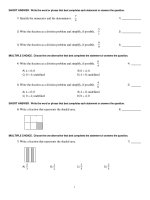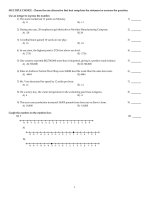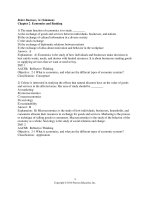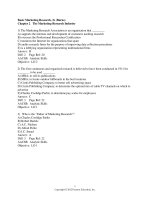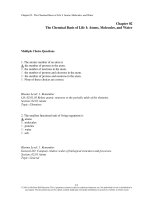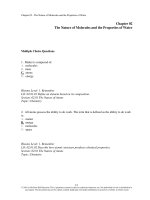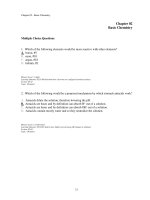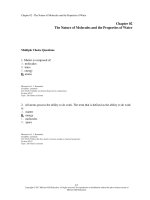Biology 3rd edition brooker test bank
Bạn đang xem bản rút gọn của tài liệu. Xem và tải ngay bản đầy đủ của tài liệu tại đây (172.1 KB, 27 trang )
Chapter 02 - The Chemical Basis of Life I: Atoms, Molecules, and Water
Chapter 02
The Chemical Basis of Life I: Atoms, Molecules, and Water
Multiple Choice Questions
1. The atomic number of an atom is
A. the number of protons in the atom.
B. the number of neutrons in the atom.
C. the number of protons and electrons in the atom.
D. the number of protons and neutrons in the atom.
E. None of these choices are correct.
Blooms Level: 1. Remember
LO: 02.01.03 Relate atomic structure to the periodic table of the elements.
Section: 02.01 Atoms
Topic: Chemistry
2. The smallest functional unit of living organisms is
A. atoms
B. molecules
C. proteins
D. water
E. salt
Blooms Level: 1. Remember
General LO: Compare relative scales of biological structures and processes.
Section: 02.01 Atoms
Topic: General
2-1
© 2014 by McGraw-Hill Education. This is proprietary material solely for authorized instructor use. Not authorized for sale or distribution in
any manner. This document may not be copied, scanned, duplicated, forwarded, distributed, or posted on a website, in whole or part
Chapter 02 - The Chemical Basis of Life I: Atoms, Molecules, and Water
Check All That Apply Questions
3. With an atomic mass of 16 and an atomic number of 8, it follows that oxygen
__X__ has eight electrons.
_____ has 16 neutrons.
__X__ can readily form bonds with 2 other atoms.
_____ weighs 16 grams.
Blooms Level: 2. Understand
LO: 02.01.03 Relate atomic structure to the periodic table of the elements.
Section: 02.01 Atoms
Topic: Chemistry
Multiple Choice Questions
4. The nucleus of an atom is composed of
A. protons.
B. neutrons.
C. electrons.
D. protons and neutrons.
E. protons and electrons.
Blooms Level: 1. Remember
LO: 02.01.01 Understand the general structure of atoms and their constituent particles.
Section: 02.01 Atoms
Topic: Chemistry
2-2
© 2014 by McGraw-Hill Education. This is proprietary material solely for authorized instructor use. Not authorized for sale or distribution in
any manner. This document may not be copied, scanned, duplicated, forwarded, distributed, or posted on a website, in whole or part
Chapter 02 - The Chemical Basis of Life I: Atoms, Molecules, and Water
5. Ernest Rutherford's key experiment on alpha particle bombardment of gold foil was
important to the development of
A. detection methods for protons.
B. alpha particle emitters.
C. gold as an element.
D. the modern model for atomic structure.
E. the concept that atoms have a homogenous distribution of protons throughout the atom.
Blooms Level: 1. Remember
LO: 02.01.01 Understand the general structure of atoms and their constituent particles.
Section: 02.01 Atoms
Topic: Chemistry
6. If a scientist were to shoot protons through an atom as Rutherford did with gold foil, he or
she would likely find that
A. most of the protons passed straight through the atom.
B. few of the protons passed straight through the atom.
C. most of the protons deflected or bounced back from the atom.
D. most of the protons would be absorbed by the atom.
E. the atom would emit protons.
Blooms Level: 3. Apply
LO: 02.01.01 Understand the general structure of atoms and their constituent particles.
Section: 02.01 Atoms
Topic: Chemistry
2-3
© 2014 by McGraw-Hill Education. This is proprietary material solely for authorized instructor use. Not authorized for sale or distribution in
any manner. This document may not be copied, scanned, duplicated, forwarded, distributed, or posted on a website, in whole or part
Chapter 02 - The Chemical Basis of Life I: Atoms, Molecules, and Water
7. The first, inner-most energy shell of an atom
A. can have a maximum of 8 electrons.
B. can have a maximum of 2 electrons.
C. is called the 2p orbital.
D. is called the 1s orbital and can have a maximum of 8 electrons.
E. is called the 2p orbital and can have a maximum of 2 electrons.
Blooms Level: 1. Remember
LO: 02.01.02 Discuss the way electrons orbit the nucleus of an atom within discrete energy
levels.
Section: 02.01 Atoms
Topic: Chemistry
8. Tritiated hydrogen (3H) differs from hydrogen (1H) in that
A. 3H has 2 more protons than 1H.
B. 3H has 2 more electrons than 1H.
C. 3H has 2 more neutrons than 1H.
D. 3H has the same number of neutrons as 1H.
E. 3H has a different electron configuration than 1H.
Blooms Level: 2. Understand
LO: 02.01.05 Explain how a single element may exist in more than one form, called isotopes,
and how certain isotopes have importance in human medicine.
Section: 02.01 Atoms
Topic: Chemistry
2-4
© 2014 by McGraw-Hill Education. This is proprietary material solely for authorized instructor use. Not authorized for sale or distribution in
any manner. This document may not be copied, scanned, duplicated, forwarded, distributed, or posted on a website, in whole or part
Chapter 02 - The Chemical Basis of Life I: Atoms, Molecules, and Water
9. Isotopes are different forms of the same element that
A. differ in their number of neutrons.
B. differ in their number of protons.
C. are all produced artificially.
D. cannot form covalent bonds.
E. cannot form ions.
Blooms Level: 2. Understand
LO: 02.01.05 Explain how a single element may exist in more than one form, called isotopes,
and how certain isotopes have importance in human medicine.
Section: 02.01 Atoms
Topic: Chemistry
10. The element found in most abundance in living organisms is
A. calcium.
B. iron.
C. iodine.
D. hydrogen.
E. sodium.
Blooms Level: 2. Understand
LO: 02.01.06 Know which elements make up most of the mass of all living organisms.
Section: 02.01 Atoms
Topic: Chemistry
2-5
© 2014 by McGraw-Hill Education. This is proprietary material solely for authorized instructor use. Not authorized for sale or distribution in
any manner. This document may not be copied, scanned, duplicated, forwarded, distributed, or posted on a website, in whole or part
Chapter 02 - The Chemical Basis of Life I: Atoms, Molecules, and Water
11. Nitrogen has 7 electrons and can form a maximum of ________ bonds with other
elements.
A. 1
B. 2
C. 3
D. 4
E. 5
Blooms Level: 2. Understand
LO: 02.02.01 Compare and contrast the types of atomic interactions that lead to the
formation of molecules.
Section: 02.02 Chemical Bonds and Molecules
Topic: Chemistry
12. Molecules
A. are derived from the ionic bonding of two or more atoms.
B. have the same physical properties as the atoms from which they were derived.
C. are not important in biological processes.
D. can form from the covalent bonding of two or more atoms.
E. cannot have a charge.
Blooms Level: 2. Understand
LO: 02.02.01 Compare and contrast the types of atomic interactions that lead to the
formation of molecules.
Section: 02.02 Chemical Bonds and Molecules
Topic: Chemistry
2-6
© 2014 by McGraw-Hill Education. This is proprietary material solely for authorized instructor use. Not authorized for sale or distribution in
any manner. This document may not be copied, scanned, duplicated, forwarded, distributed, or posted on a website, in whole or part
Chapter 02 - The Chemical Basis of Life I: Atoms, Molecules, and Water
13. Identify the ion from below.
A. Ca2+
B. He
C. H2
D. CO2
E. KCl-
Blooms Level: 2. Understand
LO: 02.02.01 Compare and contrast the types of atomic interactions that lead to the
formation of molecules.
Section: 02.02 Chemical Bonds and Molecules
Topic: Chemistry
14. Carbon has 4 electrons and hydrogen has 1 electron in its outermost electron shell. A
carbon atom can form covalent bonds with how many hydrogen atoms?
A. 0
B. 1
C. 2
D. 3
E. 4
Blooms Level: 3. Apply
LO: 02.02.01 Compare and contrast the types of atomic interactions that lead to the
formation of molecules.
Section: 02.02 Chemical Bonds and Molecules
Topic: Chemistry
2-7
© 2014 by McGraw-Hill Education. This is proprietary material solely for authorized instructor use. Not authorized for sale or distribution in
any manner. This document may not be copied, scanned, duplicated, forwarded, distributed, or posted on a website, in whole or part
Chapter 02 - The Chemical Basis of Life I: Atoms, Molecules, and Water
15. When one atom loses an electron to another atom, it results in the formation of
A. a polar covalent bond and a new molecule.
B. cations and anions that can form ionic bonds.
C. a covalent bond between the two.
D. many hydrogen bonds.
E. a nonpolar covalent bond that is difficult to break.
Blooms Level: 2. Understand
LO: 02.02.01 Compare and contrast the types of atomic interactions that lead to the
formation of molecules.
Section: 02.02 Chemical Bonds and Molecules
Topic: Chemistry
16. The strongest chemical bonds are
A. hydrogen bonds.
B. Van der Waal forces.
C. hydrophobic interactions.
D. ionic bonds.
E. covalent bonds.
Blooms Level: 1. Remember
LO: 02.02.01 Compare and contrast the types of atomic interactions that lead to the
formation of molecules.
Section: 02.02 Chemical Bonds and Molecules
Topic: Chemistry
2-8
© 2014 by McGraw-Hill Education. This is proprietary material solely for authorized instructor use. Not authorized for sale or distribution in
any manner. This document may not be copied, scanned, duplicated, forwarded, distributed, or posted on a website, in whole or part
Chapter 02 - The Chemical Basis of Life I: Atoms, Molecules, and Water
17. What type of bonding is likely to occur between two water molecules or strands of DNA?
A.
B.
C.
D.
E.
covalent
ionic
hydrogen
both hydrogen and covalent
both hydrogen and ionic
Blooms Level: 2. Understand
LO: 02.02.01 Compare and contrast the types of atomic interactions that lead to the
formation of molecules.
Section: 02.02 Chemical Bonds and Molecules
Topic: Chemistry
18. Carbon and hydrogen have similar electronegativities and combine together to form
hydrocarbon molecules. What type of bonds form between these atoms?
A. hydrogen
B. ionic
C. polar covalent
D. nonpolar covalent
E. electrostatic
Blooms Level: 2. Understand
LO: 02.02.02 Explain the concept of electronegativity and how it contributes to the formation
of polar and nonpolar covalent bonds.
Section: 02.02 Chemical Bonds and Molecules
Topic: Chemistry
2-9
© 2014 by McGraw-Hill Education. This is proprietary material solely for authorized instructor use. Not authorized for sale or distribution in
any manner. This document may not be copied, scanned, duplicated, forwarded, distributed, or posted on a website, in whole or part
Chapter 02 - The Chemical Basis of Life I: Atoms, Molecules, and Water
19. What type of bonds form from the unequal sharing of electrons?
A. hydrogen
B. ionic
C. polar covalent
D. nonpolar covalent
E. electrostatic
Blooms Level: 2. Understand
LO: 02.02.02 Explain the concept of electronegativity and how it contributes to the formation
of polar and nonpolar covalent bonds.
Section: 02.02 Chemical Bonds and Molecules
Topic: Chemistry
20. In water, MgCl2 dissociates into Mg2+ and Cl-. Based on this information what type of
bond is involved in the formation of MgCl2?
A. hydrogen
B. ionic
C. polar covalent
D. nonpolar covalent
E. electrostatic
Blooms Level: 3. Apply
LO: 02.02.01 Compare and contrast the types of atomic interactions that lead to the
formation of molecules.
Section: 02.02 Chemical Bonds and Molecules
Topic: Chemistry
2-10
© 2014 by McGraw-Hill Education. This is proprietary material solely for authorized instructor use. Not authorized for sale or distribution in
any manner. This document may not be copied, scanned, duplicated, forwarded, distributed, or posted on a website, in whole or part
Chapter 02 - The Chemical Basis of Life I: Atoms, Molecules, and Water
21. When one oxygen atom shares two pairs of electrons with another oxygen atom, O2 is
formed via a(n)
A. single covalent bond.
B. double covalent bond.
C. triple covalent bond.
D. ionic bond.
E. hydrogen bond.
Blooms Level: 2. Understand
LO: 02.02.02 Explain the concept of electronegativity and how it contributes to the formation
of polar and nonpolar covalent bonds.
Section: 02.02 Chemical Bonds and Molecules
Topic: Chemistry
22. The LEAST hydrophilic substance is
A. salt.
B. an ion.
C. oil.
D. an amphipathic molecule.
E. a gas.
Blooms Level: 2. Understand
LO: 02.03.02 List the properties of water that make it a valuable solvent, and distinguish
between hydrophilic and hydrophobic substances.
Section: 02.03 Properties of Water
Topic: Chemistry
2-11
© 2014 by McGraw-Hill Education. This is proprietary material solely for authorized instructor use. Not authorized for sale or distribution in
any manner. This document may not be copied, scanned, duplicated, forwarded, distributed, or posted on a website, in whole or part
Chapter 02 - The Chemical Basis of Life I: Atoms, Molecules, and Water
23. Amphipathic molecules
A. possess only hydrophilic properties.
B. possess only hydrophobic properties.
C. possess both hydrophilic and hydrophobic properties.
D. possess neither hydrophilic nor hydrophobic properties.
E. tend not to interact with other molecules.
Blooms Level: 1. Remember
LO: 02.03.02 List the properties of water that make it a valuable solvent, and distinguish
between hydrophilic and hydrophobic substances.
Section: 02.03 Properties of Water
Topic: Chemistry
24. For water to vaporize
A. energy must be supplied.
B. energy must be released.
C. hydrogen bonds are broken.
D. both energy must be supplied and hydrogen bonds broken.
E. both energy must be released and hydrogen bonds broken.
Blooms Level: 2. Understand
LO: 02.03.01 Describe how hydrogen bonding determines many properties of water.
Section: 02.03 Properties of Water
Topic: Chemistry
2-12
© 2014 by McGraw-Hill Education. This is proprietary material solely for authorized instructor use. Not authorized for sale or distribution in
any manner. This document may not be copied, scanned, duplicated, forwarded, distributed, or posted on a website, in whole or part
Chapter 02 - The Chemical Basis of Life I: Atoms, Molecules, and Water
25. The molarity of a solution is
A. a measure of solute concentration.
B. the weight of a solid substance.
C. often expressed as grams per unit volume.
D. reflects a measure of the amount of oil dissolved in water.
E. a scientific term for determining the solubility of a substance in water.
Blooms Level: 1. Remember
LO: 02.03.03 Understand how the molarity of a solution the number of moles of a solute per
liter of solution is used to measure the concentration of solutes in solution.
Section: 02.03 Properties of Water
Topic: Chemistry
26. Based on the colligative properties of water, what would happen if one were to add a
solute to water?
A. The freezing point of water would decrease.
B. The freezing point of water would increase.
C. The boiling point of water would increase.
D. Both the freezing point of water would decrease and the boiling point of water would
increase.
E. Nothing would change with respect to the freezing point or boiling point of water.
Blooms Level: 3. Apply
LO: 02.03.02 List the properties of water that make it a valuable solvent, and distinguish
between hydrophilic and hydrophobic substances.
Section: 02.03 Properties of Water
Topic: Chemistry
2-13
© 2014 by McGraw-Hill Education. This is proprietary material solely for authorized instructor use. Not authorized for sale or distribution in
any manner. This document may not be copied, scanned, duplicated, forwarded, distributed, or posted on a website, in whole or part
Chapter 02 - The Chemical Basis of Life I: Atoms, Molecules, and Water
27. Water
A. is nonpolar.
B. has a low heat of vaporization.
C. has cohesive properties.
D. evaporates and increases body temperature.
E. is a relatively poor solvent.
Blooms Level: 2. Understand
LO: 02.03.02 List the properties of water that make it a valuable solvent, and distinguish
between hydrophilic and hydrophobic substances.
Section: 02.03 Properties of Water
Topic: Chemistry
28. If orange juice has a pH of 4 then it can be described as
A. having a H+ concentration is 4.
B. an acidic solution.
C. an alkaline solution.
D. an acidic solution with a H+ concentration of 4.
E. None of these choices are correct.
Blooms Level: 3. Apply
LO: 02.03.05 Explain how water has the ability to ionize into hydroxide ions and into
hydrogen ions and how the H concentration is expressed as a solution’s pH.
Section: 02.03 Properties of Water
Topic: Chemistry
2-14
© 2014 by McGraw-Hill Education. This is proprietary material solely for authorized instructor use. Not authorized for sale or distribution in
any manner. This document may not be copied, scanned, duplicated, forwarded, distributed, or posted on a website, in whole or part
Chapter 02 - The Chemical Basis of Life I: Atoms, Molecules, and Water
29. The most significant role played by pH buffers is to
A. prevent fluctuations in the acidity of solutions.
B. increase the strength of acids and bases.
C. prevent fluctuations in the salinity of solutions.
D. limit major shifts in the amount of H+ and OH- in solution.
E. keep pH low.
Blooms Level: 5. Evaluate
LO: 02.03.06 Give examples of how buffers maintain a stable environment in an animal’s
body fluids.
Section: 02.03 Properties of Water
Topic: Chemistry
30. One of the ways a pH buffer helps to maintains homeostasis is by
A. increasing the amount of H+ in an acidic solution.
B.
reducing the amount of H+ in an acidic solution.
C. reducing the amount of H+ in an alkaline solution.
D. increasing the amount of OH- ions in an alkaline solution.
E. reducing the amount of OH- in an acidic solution.
Blooms Level: 3. Apply
LO: 02.03.05 Explain how water has the ability to ionize into hydroxide ions and into
hydrogen ions and how the H concentration is expressed as a solution’s pH.
Section: 02.03 Properties of Water
Topic: Chemistry
2-15
© 2014 by McGraw-Hill Education. This is proprietary material solely for authorized instructor use. Not authorized for sale or distribution in
any manner. This document may not be copied, scanned, duplicated, forwarded, distributed, or posted on a website, in whole or part
Chapter 02 - The Chemical Basis of Life I: Atoms, Molecules, and Water
31. The addition of a strong acid like HCl to an aqueous solution would result in
A. the release of H+ into the solution.
B. an increase in pH.
C. a decrease in pH.
D. both the release of H+ and an increase in pH.
E. both the release of H+ and a decrease in pH.
Blooms Level: 4. Analyze
LO: 02.03.05 Explain how water has the ability to ionize into hydroxide ions and into
hydrogen ions and how the H concentration is expressed as a solution’s pH.
Section: 02.03 Properties of Water
Topic: Chemistry
True / False Questions
32. One gram of hydrogen, which has an atomic mass of 1, would have fewer atoms than 1
gram of carbon that has an atomic mass of 12.
FALSE
Blooms Level: 3. Apply
LO: 02.01.03 Relate atomic structure to the periodic table of the elements.
Section: 02.01 Atoms
Topic: Chemistry
33. Isotopes are different forms of the same element.
TRUE
Blooms Level: 2. Understand
LO: 02.01.05 Explain how a single element may exist in more than one form, called isotopes,
and how certain isotopes have importance in human medicine.
Section: 02.01 Atoms
Topic: Chemistry
2-16
© 2014 by McGraw-Hill Education. This is proprietary material solely for authorized instructor use. Not authorized for sale or distribution in
any manner. This document may not be copied, scanned, duplicated, forwarded, distributed, or posted on a website, in whole or part
Chapter 02 - The Chemical Basis of Life I: Atoms, Molecules, and Water
34. Sulfur 35 (35S) is an isotope of 32S. These elements differ in their number of neutrons.
TRUE
Blooms Level: 2. Understand
LO: 02.01.05 Explain how a single element may exist in more than one form, called isotopes,
and how certain isotopes have importance in human medicine.
Section: 02.01 Atoms
Topic: Chemistry
35. Helium is an inert gas that rarely reacts with other elements because it has the maximum
number of valence electrons in its outer shell.
TRUE
Blooms Level: 2. Understand
LO: 02.01.01 Understand the general structure of atoms and their constituent particles.
Section: 02.01 Atoms
Topic: Chemistry
36. If lithium has an atomic number of 3 then it will have 1 valence electron.
TRUE
Blooms Level: 2. Understand
LO: 02.01.03 Relate atomic structure to the periodic table of the elements.
Section: 02.01 Atoms
Topic: Chemistry
2-17
© 2014 by McGraw-Hill Education. This is proprietary material solely for authorized instructor use. Not authorized for sale or distribution in
any manner. This document may not be copied, scanned, duplicated, forwarded, distributed, or posted on a website, in whole or part
Chapter 02 - The Chemical Basis of Life I: Atoms, Molecules, and Water
37. The electronegativity of an atom is a measure of its ability to attract electrons to its outer
shell from another atom.
TRUE
Blooms Level: 2. Understand
LO: 02.02.02 Explain the concept of electronegativity and how it contributes to the formation
of polar and nonpolar covalent bonds.
Section: 02.02 Chemical Bonds and Molecules
Topic: Chemistry
38. Table salt forms from sodium and chloride via hydrogen bonding.
FALSE
Blooms Level: 2. Understand
LO: 02.02.01 Compare and contrast the types of atomic interactions that lead to the
formation of molecules.
Section: 02.02 Chemical Bonds and Molecules
Topic: Chemistry
39. Molecules are generally rigid structures and rarely change shape.
FALSE
Blooms Level: 2. Understand
LO: 02.02.03 Describe how a molecule’s shape is important for its ability to interact with
other molecules.
Section: 02.02 Chemical Bonds and Molecules
Topic: Chemistry
2-18
© 2014 by McGraw-Hill Education. This is proprietary material solely for authorized instructor use. Not authorized for sale or distribution in
any manner. This document may not be copied, scanned, duplicated, forwarded, distributed, or posted on a website, in whole or part
Chapter 02 - The Chemical Basis of Life I: Atoms, Molecules, and Water
40. The presence of salt helps prevent oceans from freezing.
TRUE
Blooms Level: 2. Understand
LO: 02.03.02 List the properties of water that make it a valuable solvent, and distinguish
between hydrophilic and hydrophobic substances.
Section: 02.03 Properties of Water
Topic: Chemistry
41. A dehydration reaction that builds larger molecules from smaller units requires the
addition of a water molecule.
FALSE
Blooms Level: 2. Understand
LO: 02.02.04 Understand the concepts of a chemical reaction and chemical equilibrium.
Section: 02.02 Chemical Bonds and Molecules
Topic: Chemistry
42. The hydroxyl (OH-) concentration of a solution with a pH of 8 would be 10-6 molar.
TRUE
Blooms Level: 3. Apply
LO: 02.03.05 Explain how water has the ability to ionize into hydroxide ions and into
hydrogen ions and how the H concentration is expressed as a solution’s pH.
Section: 02.03 Properties of Water
Topic: Chemistry
2-19
© 2014 by McGraw-Hill Education. This is proprietary material solely for authorized instructor use. Not authorized for sale or distribution in
any manner. This document may not be copied, scanned, duplicated, forwarded, distributed, or posted on a website, in whole or part
Chapter 02 - The Chemical Basis of Life I: Atoms, Molecules, and Water
43. Most enzymes or bioactive molecules work effectively within a broad range of pH.
FALSE
Blooms Level: 2. Understand
General LO: Compare relative scales of biological structures and processes.
Section: 02.02 Chemical Bonds and Molecules
Topic: Molecular Biology
Multiple Choice Questions
44. Zn + 2H+ = Zn2+ + H2 is an example of a redox reaction. What is happening during this
interaction? Is a bond created between the atoms during this reaction?
A. Oxidation reaction and acceptance of an electron; bond is formed.
B. Reduction reaction and acceptance of an electron; no bond is formed.
C. Reduction reaction and donation of an electron; no bond is formed.
D. Covalent interaction; bond is formed.
Blooms Level: 4. Analyze
LO: 02.02.01 Compare and contrast the types of atomic interactions that lead to the
formation of molecules.
Section: 02.02 Chemical Bonds and Molecules
Type: Quantitative Reasoning
2-20
© 2014 by McGraw-Hill Education. This is proprietary material solely for authorized instructor use. Not authorized for sale or distribution in
any manner. This document may not be copied, scanned, duplicated, forwarded, distributed, or posted on a website, in whole or part
Chapter 02 - The Chemical Basis of Life I: Atoms, Molecules, and Water
45. You notice that the majority of the electrons in NaCl spend their time around the chlorine.
You also notice that the electrons in H2 are evenly distributed among the two atoms. Which
two types of bonds are represented in these molecules?
A. Covalent bonds in NaCl; ionic bonds in H2.
B. Covalent bonds in NaCl; covalent bonds in H2.
C. Ionic bonds in NaCl; ionic bonds in H2.
D. Ionic bonds in NaCl; covalent bonds in H2.
Blooms Level: 4. Analyze
LO: 02.02.01 Compare and contrast the types of atomic interactions that lead to the
formation of molecules.
Section: 02.02 Chemical Bonds and Molecules
Topic: Chemistry
46. A bottle of Na in solution and a bottle of Cl in solution are mixed together. What type of
bond will be created between the atoms, and what will be the product?
A. Covalent bonds; sodium chlorine
B. Ionic bonds; table salt
C. Hydrogen bonds; sodium hydroxide
D. Carbon bonds; carboxyl groups
Blooms Level: 3. Apply
LO: 02.02.01 Compare and contrast the types of atomic interactions that lead to the
formation of molecules.
Section: 02.02 Chemical Bonds and Molecules
Topic: Chemistry
2-21
© 2014 by McGraw-Hill Education. This is proprietary material solely for authorized instructor use. Not authorized for sale or distribution in
any manner. This document may not be copied, scanned, duplicated, forwarded, distributed, or posted on a website, in whole or part
Chapter 02 - The Chemical Basis of Life I: Atoms, Molecules, and Water
47. You've been asked to stabilize a compound whose general state is altered by excess
electrons. The element you would add to the compound to most effectively stabilize the
compound would be? Why?
A. Carbon, because it is capable of neutralizing electrons.
B. Nitrogen, because it have five electrons on its outer shell.
C. Fluorine, because it is the greediest atom on the periodic table.
D. Oxygen, because it can easily bind with the compound.
Blooms Level: 3. Apply
LO: 02.01.03 Relate atomic structure to the periodic table of the elements.
Section: 02.01 Atoms
Topic: Chemistry
48. You want to simulate the production of carbon dioxide (CO2) in a laboratory setting using
carbon and oxygen atoms. What type of reactions do you need to facilitate in order to create
CO2?
A. An oxidation, or the gain of an electron, and a reduction, or the loss of an electron.
B. An oxidation, or the loss and electron, and a reduction, or the loss of an electron.
C. An oxidation, or the gain of an electron, and a reduction, or the gain of electron.
D. An oxidation, or the loss of an electron, and a reduction, or the gain of an electron.
Blooms Level: 3. Apply
LO: 02.02.01 Compare and contrast the types of atomic interactions that lead to the
formation of molecules.
Section: 02.02 Chemical Bonds and Molecules
Topic: Chemistry
2-22
© 2014 by McGraw-Hill Education. This is proprietary material solely for authorized instructor use. Not authorized for sale or distribution in
any manner. This document may not be copied, scanned, duplicated, forwarded, distributed, or posted on a website, in whole or part
Chapter 02 - The Chemical Basis of Life I: Atoms, Molecules, and Water
49. Five unknown compounds are added to water. Four of the compounds go into solution
while one does not. What property does water possess that allows these four compounds to
dissolve? Why might the fifth compound not dissolve?
A. The positive and negative charge in water will dissolve many substances; the substance is
not structurally similar to water.
B. The negative charge of water dissolves many substances; the substance is too structurally
similar to water.
C. The positive charge of water dissolves many substances; the substance is too structurally
similar to water.
D. The nonpolar qualities of water dissolves many substances; the substance is not
structurally similar to water.
Blooms Level: 3. Apply
LO: 02.03.01 Describe how hydrogen bonding determines many properties of water.
Section: 02.03 Properties of Water
Topic: Chemistry
50. 1 mole = 1000 millimoles (mmol); 1millimole = 1000 micromoles (µmol). If a solution
contains 38231 µmol, what is that amount in mmol?
A. 382.31 mmol
B. 38.231 mmol
C. 3.8231 mmol
D. 3823.1 mmol
Blooms Level: 3. Apply
LO: 02.03.03 Understand how the molarity of a solution the number of moles of a solute per
liter of solution is used to measure the concentration of solutes in solution.
Section: 02.03 Properties of Water
Type: Quantitative Reasoning
2-23
© 2014 by McGraw-Hill Education. This is proprietary material solely for authorized instructor use. Not authorized for sale or distribution in
any manner. This document may not be copied, scanned, duplicated, forwarded, distributed, or posted on a website, in whole or part
Chapter 02 - The Chemical Basis of Life I: Atoms, Molecules, and Water
51. If 1000 millimoles make up a mole, how many grams of magnesium (Mg), which has an
atomic mass of 24.305, will make a solution of 150 µmol?
A. 3.6mg
B. 2.4mg
C. 0.24mg
D. 36mg
Blooms Level: 3. Apply
LO: 02.01.04 Quantify atomic mass using units such as daltons and moles.
Section: 02.01 Atoms
Type: Quantitative Reasoning
52. Using the periodic table as your tool, identify the atomic characteristic that would most
quickly and efficiently identify any single element:
A. number of shells
B. number of neutrons
C. number of protons and electrons
D. number of neutrons and electrons
Blooms Level: 5. Evaluate
LO: 02.01.03 Relate atomic structure to the periodic table of the elements.
Section: 02.01 Atoms
Type: Quantitative Reasoning
53. In the periodic table, the value that refers to the number of protons and neutrons is:
A. atomic mass.
B. molecular molarity.
C. atomic molarity.
D. molecular number.
Blooms Level: 5. Evaluate
LO: 02.01.03 Relate atomic structure to the periodic table of the elements.
Section: 02.01 Atoms
Topic: Chemistry
2-24
© 2014 by McGraw-Hill Education. This is proprietary material solely for authorized instructor use. Not authorized for sale or distribution in
any manner. This document may not be copied, scanned, duplicated, forwarded, distributed, or posted on a website, in whole or part
Chapter 02 - The Chemical Basis of Life I: Atoms, Molecules, and Water
54. You've been given three new elements. One element had all its protons removed, one
element had all its neutrons removed, and one element had all its electrons removed. The
effect that would have the largest effect on atomic mass would be
A. Removing the protons.
B. Removing the neutrons.
C. Removing the electrons.
D. All the changes would affect the atomic mass.
Blooms Level: 3. Apply
LO: 02.01.01 Understand the general structure of atoms and their constituent particles.
Section: 02.01 Atoms
Topic: Chemistry
55. You have been asked to synthesize a new isotope for cadmium. Which part of the original
atom would you need to manipulate in order to create an isotope?
A. Neutrons
B. Protons
C. Protons and neutrons
D. Electrons
Blooms Level: 3. Apply
LO: 02.01.05 Explain how a single element may exist in more than one form, called isotopes,
and how certain isotopes have importance in human medicine.
Section: 02.01 Atoms
Topic: Chemistry
2-25
© 2014 by McGraw-Hill Education. This is proprietary material solely for authorized instructor use. Not authorized for sale or distribution in
any manner. This document may not be copied, scanned, duplicated, forwarded, distributed, or posted on a website, in whole or part

